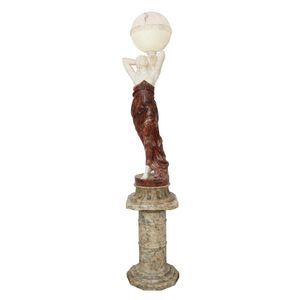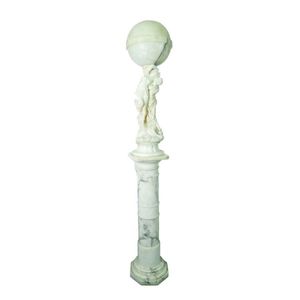Italian Alabaster Statuette Lamp on Column Stand
You must be a subscriber, and be logged in to view price and dealer details.
Subscribe Now to view actual auction price for this item
When you subscribe, you have the option of setting the currency in which to display prices to $Au, $US, $NZ or Stg.
- Alabaster - Alabaster is soft natural stone used for statuary, with a similar appearance to marble, but easier to work with. As it is softer than marble, an item made from alabaster can be scratched with a metal object, and an alabaster item does not polish to a high surface gloss like marble.
Alabaster objects can be semi-translucent. Alabaster occurs in a pure white form and also with veining from dirt. Colours vary from white through yellow and pink to brown. The veining is usually green or black but can be multicoloured.
Being semi-translucent, alabaster is often used for the bowls of figural lamps, with the figure itself being either alabaster or marble. - Laurel Leaf - The use of the laurel leaf as a decorative element can be traced back to ancient Greece and Rome, where it was closely associated with victory and honour. In these cultures, the laurel was a sacred tree that was dedicated to the god Apollo and was believed to have protective and healing properties.
In ancient Greece, the laurel wreath was awarded to victors in athletic competitions, such as the Olympic Games, as a symbol of their achievement. The wreath was also associated with academic achievement, and was often worn by scholars and poets. The Greeks also used the laurel leaf as a symbol of victory in war, and it was often depicted in artwork alongside images of triumphant warriors and heroes.
The Romans continued this tradition, and the laurel wreath became a symbol of the highest military honor, the triumph, awarded to victorious generals. The wreath was also used to crown emperors and other important officials, and was often depicted in Roman art and architecture as a symbol of power and authority.
The laurel leaf is still used as a symbol of achievement, success, and excellence, and is frequently used in logos, emblems, and other branding materials. Its association with victory and honour has made it a popular choice for awards, medals, and other forms of recognition. - Socle - The short plinth, usually cylindrical, that serves as a pedestal for a sculpture or vase
This item has been included into following indexes:
Visually similar items

A seven foot eight important and seminal marble figural lamp 'Sogno Di Sposa', sculpted by Professor Giuseppe Bessi (Italian 1857-1922), late 19th century, in various marbles; castellina, scaglione, bordiglio and agate, the outstretched semi robed figure d

A Charles & Ray Eames Time-life black walnut 'A' stool. Height 38.5 cm. Depth 32.5 cm

A large finely cast and chased bronze Grand Tour Borghese urn, patinated bronze decorated in high relief with scrolls acanthus, beaded rim, reeded handles with satyr mask terminals and on a pedestal base with square plinth, height 74 cm, width 63 cm

An Italian marble sculpture of a semi nude female on pedestal, signed Allegrain. The pedestal 95.5 cm high, 40 cm diameter. The figure 86 cm high
